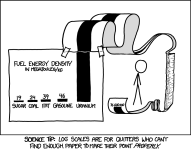lpetrich
Contributor
An Unexpected Current That's Remaking American Politics - POLITICO Magazine
Also, renewable-energy development has done what nuclear-energy development has failed to do, even though electricity-storage technologies are also good for nuclear energy, with most reactors being run on constant throttle.
The pResident's burlesques aside, it must be conceded that intermittency is a big problem with wind and solar energy. But help is on the way in the form of batteries.At the annual National Republican Congressional Committee dinner in Washington this month, President Donald Trump made news with some curious remarks about wind power. What went viral was his untrue suggestion that the noise from wind turbines causes cancer, but his warning that home values instantly plunge 75 percent when a windmill is built nearby was equally false. He also claimed wind power is inordinately expensive, when in fact in much of America it is now the cheapest source of electricity. The president then play-acted a scene of a woman complaining to her husband about wind power’s supposed unreliability: “I can’t watch television, darling. Darling, please tell the wind to blow!”
Talk about vigorous development. Like what wind turbines and photovoltaic cells have had over the last 40-odd years. I am particularly surprised by the success of PV -- I'd expected solar-thermal generation to be what made it.Wind and solar generation has almost quintupled in the past decade, providing 9 percent of U.S. electricity last year without emitting any greenhouse gases. ... But lithium-ion batteries were too expensive to use to capture power on the grid before yet another technology transformation—the growth of electric vehicles, from zero a decade ago to more than 1 million on American roads today—drove down their costs through mass production.
Now grid storage is poised to grow at a faster pace than the electric cars that made it cost-effective, and even faster than the renewables it will help to accommodate on the grid. Last year, Florida Power & Light completed a 10-megawatt grid battery hailed as the largest of its kind in the world; last month, FPL announced a battery project more than 40 times larger. Republican regulators in Arizona recently approved more than twice as much power storage in their state as the entire country installed last year; Hawaii is building more than three times as much, and California nearly five times as much. Tom Buttgenbach, the CEO of 8minutenergy Renewables, says his firm alone has signed contracts to build nearly a gigawatt of grid storage in the U.S., more than two thirds of the current nationwide total, in just the past four months.
Also, renewable-energy development has done what nuclear-energy development has failed to do, even though electricity-storage technologies are also good for nuclear energy, with most reactors being run on constant throttle.

